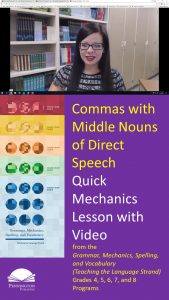Commas with Middle Nouns of Direct Speech
Commas with Middle Nouns of Direct Speech
Play the quick video lesson HERE and click the upper left back arrow to return to this lesson.
Common Core Language Standard 2
When your mom tells you to walk directly home, she means with no side trips. She is talking directly to you. If she mentions your full name directly, such as “Go directly home, John Michael Vincent, and no where else” you know she means business. Remember that direct means “face to face with nothing in between.”
Today’s mechanics lesson is on commas with middle nouns of direct speech. Remember that a noun can be named as in a proper noun or unnamed as in a common noun. When we talk to a person in our speech or writing, that person is a noun of direct speech. We place commas after nouns of direct speech used at the beginning of a sentence and before nouns of direct speech used at the end of sentences.
Now let’s read the mechanics lesson and study the examples.
Place commas before and after nouns of direct speech used in the middle of sentences.
Example: “If you wait your turn, Chelsea, you will get your fair share,” the teacher said.
Now circle or highlight what is right and revise what is wrong according to mechanics lesson.
Practice: Jake, you really are a handful. If you would stop messing around, Jake you could make something of yourself. It’s just that easy brother, but you’ve got to try.
Let’s check the Practice Answers.
Mechanics Practice Answers: Jake, you really are a handful. If you would stop messing around,Jake,you could make something of yourself. It’s just that easy,brother, but you’ve got to try.
Now let’s apply what we have learned.
Writing Application: Write your own sentence using a noun of direct speech in the middle of a sentence.
*****

Pennington Publishing Grammar Programs
Teaching Grammar, Usage, and Mechanics (Grades 4, 5, 6, 7, 8, and High School) are full-year, traditional, grade-level grammar, usage, and mechanics programs with plenty of remedial practice to help students catch up while they keep up with grade-level standards. Twice-per-week, 30-minute, no prep lessons in print or interactive Google slides with a fun secret agent theme. Simple sentence diagrams, mentor texts, video lessons, sentence dictations. Plenty of practice in the writing context. Includes biweekly tests and a final exam.
Grammar, Usage, and Mechanics Interactive Notebook (Grades 4‒8) is a full-year, no prep interactive notebook without all the mess. Twice-per-week, 30-minute, no prep grammar, usage, and mechanics lessons, formatted in Cornell Notes with cartoon response, writing application, 3D graphic organizers (easy cut and paste foldables), and great resource links. No need to create a teacher INB for student make-up work—it’s done for you! Plus, get remedial worksheets, biweekly tests, and a final exam.
Syntax in Reading and Writing is a function-based, sentence-level syntax program, designed to build reading comprehension and increase writing sophistication. The 18 parts of speech, phrases, and clauses lessons are each leveled from basic (elementary) to advanced (middle and high school) and feature 5 lesson components (10–15 minutes each): 1. Learn It! 2. Identify It! 3. Explain It! (analysis of challenging sentences) 4. Revise It! (kernel sentences, sentence expansion, syntactic manipulation) 5. Create It! (Short writing application with the syntactic focus in different genre).
Get the Diagnostic Grammar, Usage, and Mechanics Assessments, Matrix, and Final Exam FREE Resource:
![]()
